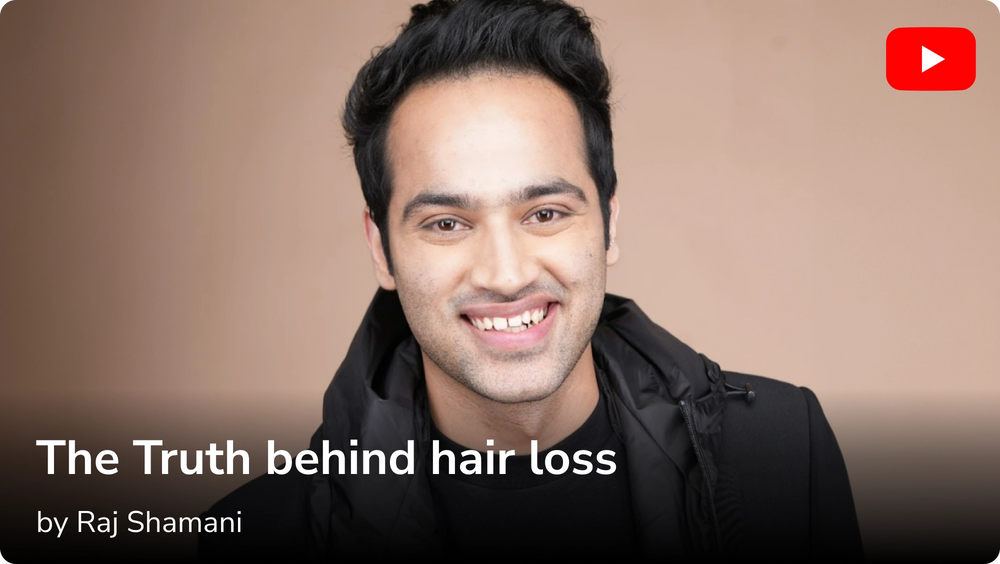As we age, changes in our hairline are common and most often a source of concern. While some people experience a gradual shift in their hairline, others may notice more significant changes, such as hair thinning or loss. Understanding the difference between a mature hairline vs receding hairline is crucial for addressing hair concerns effectively.
While noticing changes in your hairline can feel alarming, it’s important to understand that not every shift signals severe hair loss. Early awareness can empower you to take timely action. Whether it’s maturing or receding, your hairline is telling a story about your body’s internal balance. Identifying this story early allows you to manage it before it escalates into visible thinning or baldness.
A mature hairline is a natural part of ageing and typically involves a slight upward shift of the hairline. In contrast, a receding hairline can indicate the early stages of male or female pattern baldness, where the hairline moves back more dramatically. Recognizing these differences can help in choosing the right treatments and managing expectations.By identifying your hairline type, you can take proactive steps, such as trying Traya's free hair test, to address any underlying issues.
In this blog, let's explore the characteristics of mature and receding hairlines, explain how to identify each type, and discuss potential causes and treatments to help you maintain a healthy hairline.
Understanding Hairlines: Mature Hairline vs Receding
What many people miss is that both mature and receding hairlines follow a pattern, but they differ in pace and progression. A mature hairline typically settles into place and stabilises, whereas a receding hairline keeps moving back unless managed with the right interventions. Knowing this can help you choose whether you need preventive care or corrective treatment.
Definition of a Mature Hairline
A mature hairline often goes unnoticed because it progresses slowly and doesn’t usually impact overall hair density dramatically. It is your body’s natural adjustment as you transition from adolescence to adulthood. This change is rarely a cause for concern unless accompanied by rapid thinning or excessive shedding, in which case an expert evaluation is advisable.
Definition of a Receding Hairline
A receding hairline, however, is more than just a cosmetic concern. It reflects underlying biological factors such as genetics, hormones, and even environmental stressors. The earlier you recognise the signs, like noticeable temple thinning or increasing forehead exposure, the better your chances of slowing or managing the progression effectively.
Causes and Characteristics of a Mature Hairline
Besides ageing, other factors like lifestyle choices and nutrition can subtly influence how your mature hairline develops. While this type of hairline is largely predetermined by genetics, maintaining scalp hygiene, managing stress, and following a balanced diet can help preserve your existing hair density and overall scalp health.
Natural Aging Process and Its Impact on Hairline
The natural ageing process plays a significant role in hairline changes. As we age, our bodies undergo various changes, and hair growth is no exception. The hair growth cycle slows down, and hair follicles may shrink over time. This can lead to a slight upward shift of the hairline, which is often more noticeable in men. This process is gradual and usually stabilises once the mature hairline is established.
Characteristics of a Mature Hairline
A mature hairline is characterised by a minor recession of the hairline, typically forming an "M" shape. The recession is usually symmetrical and affects the temples more than the centre of the forehead. Unlike a receding hairline, which can progress rapidly and unevenly, a mature hairline remains relatively stable once it has settled. The hair density may slightly decrease, but there are no significant bald patches or severe thinning.
Common Age Range for Developing a Mature Hairline
The transition to a mature hairline generally occurs between the ages of 17 and 29. This change is a normal part of ageing and should not be a cause for concern. It is essential to recognize that this shift is not an indication of future hair loss or baldness but rather a natural adjustment of the hairline as one matures.
Expert Commentary on the Normalcy of a Mature Hairline
Dermatologists and hair specialists often reassure individuals experiencing this change that a mature hairline is a normal and expected part of ageing. Dr. John Smith, a renowned trichologist, states, "A mature hairline is a natural evolution that most men experience. It is not necessarily a precursor to balding and should be distinguished from a receding hairline, which involves more significant hair loss." Understanding this distinction can help alleviate unnecessary anxiety and allow individuals to embrace their hairline changes with confidence.
Also read: Stages of Receding Hairline
Causes and Characteristics of a Receding Hairline
Environmental triggers like pollution, UV damage, and poor scalp hygiene can speed up hairline recession. Additionally, nutritional deficiencies — especially iron and vitamin D — play a crucial role. If your diet lacks these essential nutrients, it weakens the hair shaft and accelerates hair loss at the front of the scalp. Addressing these gaps early can make a significant difference.
Genetic Factors Influencing Hair Loss
Genetics play a pivotal role in hairline recession. If you have a family history of male or female pattern baldness, you are more likely to experience a receding hairline. Androgenetic alopecia, the medical term for hereditary hair loss, is influenced by genes inherited from both parents. This condition affects the hair growth cycle, leading to shorter anagen (growth) phases and longer telogen (resting) phases, resulting in gradual hair thinning and loss.
Hormonal Influences, Particularly DHT
Hormones, especially dihydrotestosterone (DHT), significantly impact hair loss. DHT is a byproduct of testosterone and binds to hair follicles, causing them to shrink and produce thinner hair. Over time, these follicles may stop producing hair altogether. Men with higher levels of DHT are more prone to experiencing a receding hairline. This hormonal influence explains why hair loss patterns are often more pronounced in men than in women.
Signs of a Receding Hairline and How It Progresses
A receding hairline typically starts with thinning at the temples and the formation of an "M" or "V" shape. As the condition progresses, the hairline continues to move backward, exposing more of the forehead. The recession may be accompanied by thinning on the crown of the head. Unlike a mature hairline, a receding hairline often progresses unevenly and can lead to significant hair loss over time. Early signs to watch for include increased hair shedding, widening of the part line, and noticeable thinning around the temples.
Case Studies: Individuals with Receding Hairlines
Many individuals have experienced the challenges of a receding hairline. For example, Mark, a 35-year-old man, noticed his hairline receding in his late twenties. Initially, he dismissed it as a mature hairline, but over the years, the recession became more pronounced, and he sought medical advice. Another case is Lisa, a 45-year-old woman who experienced a gradual hairline recession after menopause, indicating the role of hormonal changes in female hair loss.
How to Differentiate Between a Mature and Receding Hairline
Beyond visual clues, pay attention to the rate of change. A mature hairline tends to stabilise, while a receding hairline may visibly shift over weeks or months. Also, monitor accompanying symptoms like itchiness, inflammation, or increased hair fall in the shower — these are stronger indicators of active recession rather than natural maturing.
Mature Hairline Vs Receding hairline: Key Visual Indicators to Look For
When trying to determine whether you have a mature hairline or a receding hairline, key visual indicators can be helpful. A mature hairline is typically characterised by a minor recession that forms an "M" shape, primarily affecting the temples. The recession is usually symmetrical and remains stable over time. On the other hand, a receding hairline is marked by more significant and uneven hair loss. The hairline moves backward, exposing more of the forehead, and the recession progresses over time. Bald patches and severe thinning may also become noticeable, particularly around the temples and crown.

Changes in Hair Density and Pattern
Hair density and pattern changes are critical factors in distinguishing between a mature and receding hairline. A mature hairline will show a slight reduction in density but generally maintains an even distribution of hair. The hairline remains well-defined, though slightly higher than in youth. In contrast, a receding hairline often exhibits significant thinning and uneven hair loss. The density decreases more rapidly, and the hairline becomes less defined and more irregular. The pattern of hair loss can also spread to other areas of the scalp, such as the crown.
Also Read: How to Increase Hair Density Naturally
Tools and Tests to Assess Hairline Changes
For even better accuracy, consider tracking your hairline changes over time using scalp mapping apps or hair scanners at dermatology clinics. These tools measure hair density and follicle health, providing early warnings before visible thinning appears. Regular self-checks every two to three months can also catch subtle changes that daily observation might miss.
Several tools and tests can help assess hairline changes and determine whether you have a mature or receding hairline:
- Traya's Hair test: Take Traya's Free Hair Test, designed by doctors, to analyze the root causes of your hair fall factors like genetics, scalp health, and hormones etc.
- Mirror Test: Stand in front of a mirror with good lighting and examine your hairline closely. Look for signs of symmetry, recession patterns, and density changes.
- Photo Comparison: Compare recent photos of your hairline with older ones. This can help track progression and identify any significant changes over time.
- Hair Density Test: Part your hair in different sections and assess the density. Use a comb to check for thinning areas and compare them with denser parts of your scalp.
-
Scalp Analysis: Visit a dermatologist or trichologist for a professional scalp analysis. They can use specialised tools like a dermatoscope to examine your hair follicles and scalp health.

Video Guide: How to Examine Your Hairline
Including a video guide can provide a practical, step-by-step approach to examining your hairline. The video can demonstrate how to use the mirror test, photo comparison, hair density test, and what to look for in each step. Visual aids and expert tips can help viewers understand the process better and accurately assess their hairline.
Also Read: How to Strengthen Hair Naturally
Treatment and Management Options
Apart from medications and surgical options, addressing lifestyle factors plays a big role. Improving sleep quality, reducing sugar intake, and adding anti-inflammatory foods like turmeric and green leafy vegetables can support hair health. Complementing these habits with regular scalp massages enhances blood flow to the follicles, promoting a healthier environment for hair growth.
When to Seek Professional Advice
It is crucial to seek professional advice when you notice significant changes in your hairline or if you are unsure whether you have a mature or receding hairline. Early intervention can help manage hair loss effectively. Consulting a dermatologist or trichologist can provide a proper diagnosis and tailored treatment plan. Look for signs such as rapid progression of hair loss, bald patches, and noticeable thinning, which may indicate a need for professional evaluation.
Non-Surgical Treatments for Hair Loss
Several non-surgical treatments can help manage hair loss and promote hair regrowth:
- Minoxidil: An over-the-counter topical treatment that stimulates hair growth and slows down hair loss. It is effective for both men and women.
- Finasteride: A prescription oral medication that reduces DHT levels, a hormone linked to hair loss. It is primarily used for male pattern baldness.
Both treatments have shown positive results in slowing hair loss and promoting regrowth, but they require continuous use to maintain benefits.
Also Read: Minoxidil before and after
Surgical Options: Hair Transplant, Scalp Reduction
For more advanced hair loss, surgical options may be considered:
- Hair Transplant: Involves moving hair follicles from a dense area to the thinning or balding areas. Techniques include Follicular Unit Transplantation (FUT) and Follicular Unit Extraction (FUE).
- Scalp Reduction: Involves removing bald scalp areas and stretching the remaining hair-covered scalp to cover the bald spots. This option is less common but can be effective for specific cases.
These procedures can provide long-lasting results but come with higher costs and potential risks, so it’s essential to discuss them thoroughly with a specialist.
Natural Remedies and Lifestyle Changes
You can also explore herbal rinses with ingredients like neem and amla to soothe the scalp and strengthen roots. Alongside dietary changes, adopting mindful living practices — like journaling or breathwork — can further regulate stress hormones that negatively impact hair follicles. Consistency with these small steps often yields visible improvements over time.
Natural remedies and lifestyle changes can support hair health and slow down hair loss:
1. Diet: Nourish Your Hair from Within
A balanced diet rich in essential vitamins and minerals is crucial for hair health. Nutrients like biotin, zinc, and iron play a significant role in strengthening hair follicles and promoting growth. Biotin (Vitamin B7) helps produce keratin, a protein that makes up the structure of hair. Zinc is vital for repairing hair tissue and ensuring the proper functioning of the oil glands around hair follicles, while iron helps red blood cells carry oxygen to your hair’s roots, aiding in growth.
Also read: Best foods for Hair Growth in India
2. Stress Management: Protect Your Hair from Within
Stress is a well-known factor in hair loss, particularly in conditions like telogen effluvium, where hair prematurely enters the resting phase. Managing stress is, therefore, key to maintaining healthy hair. Engaging in regular stress-reducing activities can help protect your hair and even promote regrowth.
Effective Stress-Reduction Practices:
- Yoga: Helps improve circulation and reduce tension, benefiting both your body and scalp.
- Meditation: Calms the mind and reduces overall stress levels, which can mitigate hair loss.
- Regular Exercise: Boosts blood circulation, ensuring that your hair follicles receive the nutrients they need.
Incorporating these practices into your daily routine can create a positive impact on both your mental health and your hair’s vitality.
Also read: Stop Hair Loss and Regrow Hair Naturally in 3 Weeks
3. Proper Hair Care: Gentle Handling for Stronger Hair
Taking care of your hair involves more than just using the right products. It’s also about how you treat your hair on a daily basis. Harsh treatments, such as frequent dyeing, bleaching, and the use of heat styling tools, can weaken hair strands and lead to breakage. Additionally, environmental factors like excessive sun exposure and pollution can cause further damage.
Hair Care Tips:
- Avoid Harsh Chemicals: Choose shampoos and conditioners that are sulphate-free and contain natural ingredients.
- Heat Protection: Always use a heat protectant spray before blow-drying, straightening, or curling your hair to minimise damage.
- Sun Protection: Wear a hat or use a UV-protective spray when spending time outdoors to shield your hair from harmful rays.
Natural remedies and lifestyle changes play a vital role in maintaining healthy hair and preventing hair loss. By focusing on a balanced diet, managing stress effectively, and handling your hair with care, you can support hair health from within and achieve stronger, more resilient locks. These practices not only enhance the appearance of your hair but also contribute to overall well-being.
Also Read: Dermatologist Recommended Shampoo for Dry and Frizzy Hair in India
Psychological Impact and Coping Strategies
Beyond external care, nurturing a healthy mindset is essential. Accepting gradual hairline changes as part of life reduces anxiety, which itself is a trigger for hair fall. Leaning on trusted support groups or even hair coaches from platforms like Traya can provide both practical guidance and emotional reassurance during this journey.
Emotional Effects of Hairline Changes
Experiencing changes in your hairline, whether it’s maturing or receding, can significantly impact your emotional well-being. Many individuals feel a sense of loss, lowered self-esteem, and anxiety over their changing appearance. Society often equates a full head of hair with youth and vitality, making these changes particularly challenging.
Coping Strategies and Support Systems
Coping with hairline changes involves both practical and emotional strategies:
- Acceptance: Understanding that hairline changes are a natural part of aging for many people can help in accepting and dealing with these changes.
- Styling Choices: Experiment with hairstyles that make you feel confident and comfortable. Professional stylists can offer advice on cuts and styles that minimize the appearance of a receding hairline.
- Support Systems: Sharing your concerns with friends, family, or support groups can provide emotional relief. Engaging in conversations with others facing similar issues can be incredibly supportive.
Conclusion
Your hairline is not just a cosmetic feature — it’s a reflection of your internal health. Whether maturing or receding, early recognition and proactive care can slow progression and support regrowth. Remember, consistency is your greatest ally. A holistic approach combining internal health, topical treatments, and lifestyle changes is the best way forward.
In conclusion, achieving and maintaining healthy, resilient hair involves a holistic approach that encompasses proper nutrition, effective stress management, and mindful hair care practices. A balanced diet rich in essential vitamins and minerals like biotin, zinc, and iron provides the necessary nutrients for strong hair growth. Managing stress through activities like yoga and meditation helps prevent hair loss triggered by emotional and physical strain. Additionally, gentle hair care routines that avoid harsh treatments and protect against environmental damage ensure your hair remains strong and vibrant.
FAQs
Can Stress Cause a Receding Hairline?
A: Yes, stress can exacerbate hair loss, leading to a receding hairline. Stress affects the body's hormonal balance, which can disrupt the hair growth cycle, pushing more hair follicles into the telogen (resting) phase, where they are more likely to fall out. This condition, known as telogen effluvium, can cause noticeable thinning and recession of the hairline. Managing stress through relaxation techniques such as meditation, yoga, and deep-breathing exercises, as well as maintaining a healthy lifestyle with regular exercise and adequate sleep, can help mitigate the effects of stress on your hair.
Is It Possible to Reverse a Receding Hairline?
A: While it's challenging to completely reverse a receding hairline, treatments like minoxidil and finasteride can slow down the process and promote hair growth. Minoxidil, a topical treatment, increases blood flow to hair follicles, stimulating growth and extending the anagen (growth) phase of the hair cycle. Finasteride, an oral medication, works by inhibiting the conversion of testosterone to dihydrotestosterone (DHT), a hormone linked to hair loss. Although these treatments can be effective in slowing hair loss and promoting regrowth, their effects are typically more pronounced in the crown area rather than the hairline. Consistent use is necessary to maintain results, and consulting a healthcare professional for personalised treatment recommendations is advised.
How Can I Tell If My Hairline Is Maturing or Receding?
A: A mature hairline is a natural part of aging, showing minor, symmetrical recession, usually about 1-2 centimeters above the juvenile hairline. This process typically occurs in men between the ages of 17 and 30 and is characterized by a slight upward movement of the hairline while maintaining an overall even shape. In contrast, a receding hairline often progresses more significantly and unevenly, usually due to genetic or hormonal factors such as increased levels of DHT. It typically starts with thinning at the temples and can create an M-shaped pattern as it advances. Monitoring changes in hair density and pattern over time can help you determine whether your hairline is maturing or receding. If you notice rapid progression or significant asymmetry, consulting a dermatologist or trichologist can provide clarity and appropriate treatment options.
Can changing my diet help stabilise my hairline?
A: Yes. Including foods rich in iron, zinc, and protein supports hair follicle strength and reduces hairline thinning. Hydration and balanced meals improve blood circulation to the scalp, supporting healthier hair.
Does wearing hats or helmets cause hair recession?
A: No. Wearing hats or helmets does not directly cause hair loss. However, poor hygiene and prolonged moisture buildup under headgear can create an unhealthy environment for the scalp.
References:
- Hair loss Statistics of 5 lakh Indian Men:
https://traya.health/blogs/hair-care/hair-loss-statistics-of-5-lakh-indian-men - Female Hair loss Statistics
https://traya.health/blogs/hair-care/Female-hair-loss-statistics





















